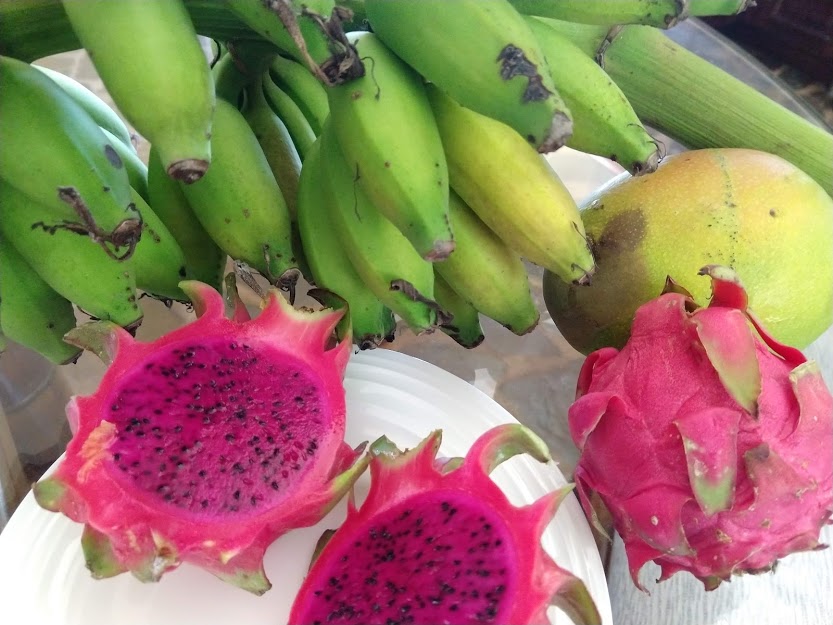Tropical and Exotic Fruit
Belize is blessed with an abundance of fresh fruit year-around. Those of us that live here can’t imagine a day without bananas, papayas, pineapples, and oranges. Most would be surprised to learn though that there is a season for just about everything else. So many fruits cannot be found year-around and are only seasonal. It appears, to me, the best time to get the unique local fruits is springtime.
Many of the local fruits are too delicate to export, so be sure to enjoy as much Belizean fruit as you can while in country. Almost all these unique fruits have an added benefit of being called “super foods” by many in the health industry, being packed with extra vitamins and cancer-fighting nutrients.
Belize boasts of fruits like guava, strawberry guava, passion fruit, mammie apple, rose apple, dragon fruit, Mollie apple, cashew apple, and really the list is endless. While you may say to yourself “I’ve had guava before,” there are many varieties here and each has its own unique taste and flavor. The strawberry guava is by far my favorite.
Rose apples are small round fruits that have a hollow inside with a seed pod. You eat the skin. It tastes and smells just like roses!
Some people mistakenly call the Mollie apple a rose apple, even though it’s different from the previously mentioned rose apple. The Mollie apple fruit, a nickname for Malay apple tree, is bright red but has a texture and flavor and shape of a pear. The mammie apple has brown fuzz on the outside, shaped like a small football, but bright orange and creamy on the inside, with a hint of chocolate flavor to it. Many people don’t realize that you eat the seeds of passion fruit and not the skin. The seeds are bursting with flavor and intense in taste.
The cashew apple has a cashew nut on it—but don’t eat it because it is poisonous. Instead, eat the fruit. This fruit is so juicy one should only eat it standing up and leaning forward as the juice goes everywhere and is especially sticky and messy when one tries to eat it in a car. Those who know how to roast the cashew properly, do, and later sell the cashew nuts. Sometimes the small bags can be found at the gas stations or by people selling them roadside. This is a labor-intensive process, which explains why local Belize cashews are somewhat expensive.
In Belize, not much fruit is sold at the grocery stores. Instead, one goes to the markets or to fruit and vegetable stands to purchase produce. Sometimes trucks come around selling produce as well. There are also many roadsides stands along the highways. When packing snacks to go hiking, snorkeling, and traveling the country the unique fruits are not only healthy, but are quite abundant. Discover which ones are your favorite!
Many hotels and restaurants want to expose tourists to different flavors and feature them in their meals to highlight the fresh, locally produce products of Belize.
What things cost:
Bananas-8 to 10-$.50US/$1BZ
Oranges/grapefruits-a 50-pound sack delivered-$7US/$14BZ or 8 oranges for .50US/$1BZ at the stands it is about 4 grapefruit for $1BZ
Pineapple-$1.25US/$3.50BZ
Cilantro—large bunch for $1BZ
Papaya-It depends on the size, but average about $1.50US/$3BZ
Large Mangos-.50US/$1BZ each, while the small mangos can go for 7 for .50US/$1BZ
Limes: Prices fluctuate on availability. During peak season it’s about 7 for $1BZ, but when they become scarce it is 2 limes for $1BZ
Dragon fruit—2 for $1BZ
*You don’t have to purchase an entire watermelon, as you can purchased a half, quarter, or even just a slice. You can also buy just one “stick” of celery. Just ask.
Passion fruit, mollie apple, star fruit, and pineapple (above.) Apple bananas, dragon fruit, and mango (below.)








